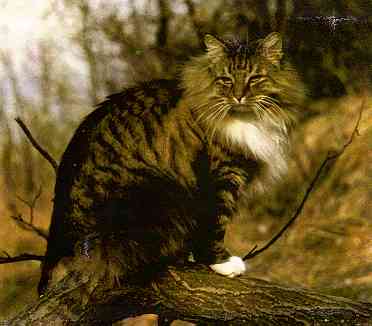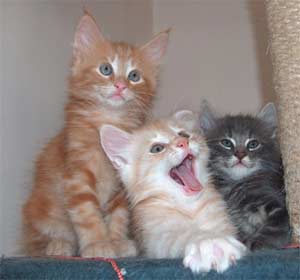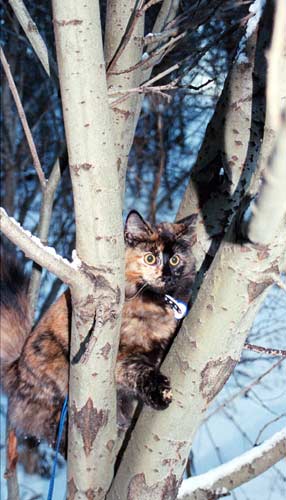About
the breed
Obscure as its origins may be, there is no doubt that the Norwegian Forest Cat has lived wild in the forests for as long, if not longer, than man. How it came to be domesticated is uncertain, but it soon became valued as a mouse-catcher in barns and houses, and Norwegian sailors almost certainly took cats with them on their voyages to Europe and America
In recent years, a theory has emerged that, when the Black Death swept Norway during the early years of the 14th century, the Norwegian Forest Cat moved back to the forests, where they developed the features, coat and characteristic appearance they have today.

Truls

Interest grew steadily, and in 1975 "Norst skogkattring" was founded, with the aim of getting the cats recognised by FIFé. After much hard work this ambition was finally realised, and in 1977 a male, Truls, became the first Norwegian Forest Cat to receive official FIFé recognition.
Summer and winter coats differ significantly. In winter, the cats have a thick coat, characterised by its elegant ruff and "knickerbockers". In spring, the coat becomes thinner, but the knickerbockers are always visible and there is not much difference in the tail. Although the Forest Cat originated in the wild, it is a great indoor cat, providing it has enough space to move about. Blessed with an even temprament, the Norwegian Forest Cat is good-natured, lively and a keen hunter. As a breed, they usually have a strong personality, enjoy the company of children and other animals, and often form a special connection with one particular member of the family.
In Iceland, there has been a tendency to refer to all semi-longhaired as Norwegian Forest Cats, even if they do not have a pedigree.This is most definitely wrong, as a true Norwegian Forest Cat always has a pedigree from a breeding club.
If you intend buying a thoroughbred Norwegian Forest Cat, you should be sure that it comes with a pedigree from a breeding club. In Iceland, the only club of this type is Kynjakettir, which is also a registered member of FIFé. If a cat does not have a pedigree, it is difficult to tell whether it is a true Norwegian Forest Cat, or just an ordinary, semi-longhaired housecat. As might be expected, Norwegian Forest Cats cannot be bred with cats of another kind.
